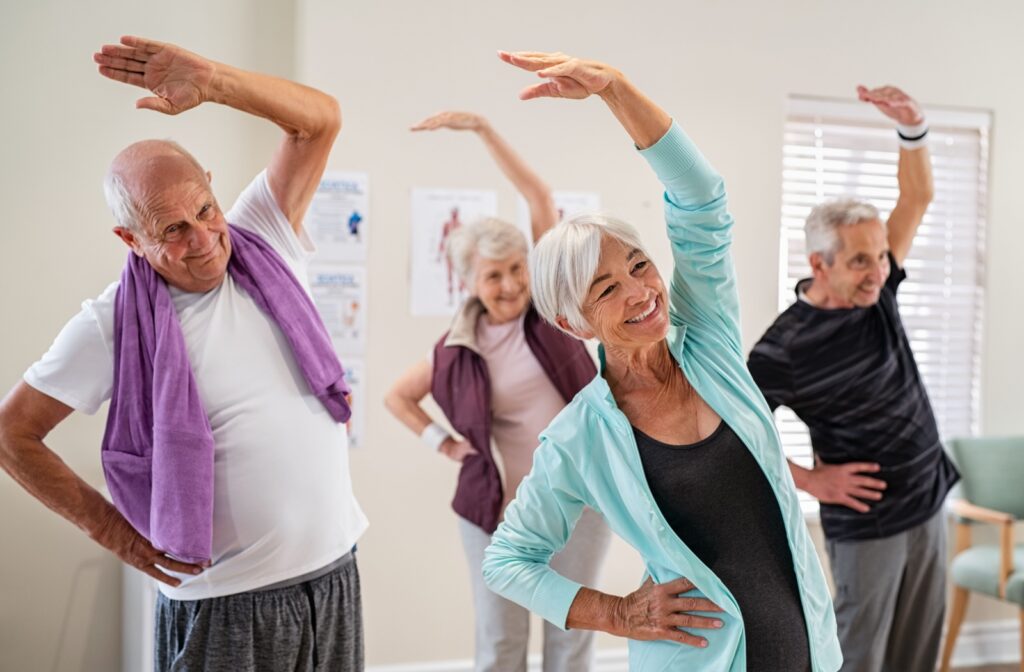Our bodies undergo various changes that can impact our overall health and well-being. Older adults often experience a decline in balance due to factors like loss of muscle mass, decreased flexibility, and changes in vision or hearing.
Balance exercises are physical activities that help improve stability and coordination, thereby helping reduce the risk of falls and injuries. These exercises are especially important for older adults, as they can help maintain mobility, independence, and a better quality of life.
Here are some reasons why seniors should incorporate balance exercises into their routine:
- Reduce the risks of falls
- Improve muscle strength and flexibility
- Enhance overall coordination and reaction time
- Maintain bone density
- Boost confidence and independence
- Increase social engagement
- Benefits for mental health
Reduce the Risks of Falls
Falls are often a concern for older adults, as they can lead to serious injuries such as fractures and head trauma. According to the Centers for Disease Control and Prevention (CDC), 1 in 4 older adults falls each year, with more than 3 million emergency department visits and over 800,000 hospitalizations.
Performing balance exercises can help older adults improve their stability and decrease the risk of falls. These exercises focus on strengthening the muscles that support posture and balance while improving coordination and reaction time.
Improve Muscle Strength & Flexibility
As we age, our muscle mass decreases, making it harder to perform daily activities and affecting our balance. However, regular exercise, including balance exercises, can help older adults maintain or increase muscle strength and flexibility.
Balance exercises often involve movements that engage various muscle groups in the legs, core, and upper body. These muscles are crucial for maintaining stability and preventing falls. By incorporating these exercises into their routine, older adults can improve their overall strength and flexibility, making it easier to perform daily tasks and activities.
Enhance Overall Coordination & Reaction Time
Balance exercises also help improve coordination and reaction time in older adults. As we age, our reflexes slow down, making it challenging to respond quickly to unexpected situations or movements. By regularly practicing balance exercises, older adults can train their bodies to react faster and maintain better balance in different situations.
Balance exercises that involve shifting weight, changing directions, or standing on one leg are especially beneficial for improving coordination and reaction time. These movements challenge the body to maintain stability while responding quickly, helping older adults become more agile and better able to prevent falls.
Maintain Bone Density
Balance exercises can enhance muscle strength and coordination and help maintain bone density. As we age, our bones become weaker and more prone to fractures. Weight-bearing exercises like standing or walking on one leg can help strengthen bones and prevent osteoporosis.
By regularly incorporating balance exercises into their routine, older adults can reduce their risk of bone-related injuries and maintain their overall bone health.
Promote Independence & Confidence
One significant benefit of balance exercises is the increased sense of independence and confidence they can provide older adults. By improving muscle strength, flexibility, and coordination, older adults can feel more in control of their bodies and movements.
This increased sense of independence can translate into increased confidence in performing daily activities without fear of falling or getting injured. Regularly participating in balance exercises can also give seniors a sense of accomplishment and pride as they see improvements in their balance and overall physical abilities.
Increase Social Engagement
It’s common for older adults to become more socially isolated, which can negatively affect their overall health and well-being. Participating in group balance exercises can be a great way for older adults to stay physically active while engaging with others.
Group classes or exercises provide older adults with an opportunity to connect with others who share similar interests and goals, promoting social interaction and a sense of community. This can help combat feelings of loneliness and depression, which are common in older adults.
Benefits for Mental Health
Balance exercises can benefit older adults’ physical health and positively affect their mental health. Research has shown that regular exercise can improve mood, reduce symptoms of depression and anxiety, and enhance cognitive function.
Since balance exercises require concentration and focus, they can help older adults stay mentally sharp and improve their memory. Moreover, the endorphins released during exercise can improve mood and reduce stress levels, helping promote a more positive outlook on life.
Examples of Balance Exercises for Seniors
Various balance exercises can be performed by older adults, catering to different levels of physical abilities. Some examples include:
- Standing on one leg
- Heel-to-toe walking
- Tai chi
- Yoga poses, such as tree pose, or warrior pose
- Seated exercises, like marching with arms and feet
It’s important for older adults to consult with a doctor or physical therapist before starting any new exercise routine, especially if they have any pre-existing health conditions.

Staying Active & Healthy
Balance exercises are crucial for older adults to maintain their independence and overall well-being. They can help prevent falls, improve physical abilities, increase social engagement, and promote mental health. By incorporating balance exercises into their daily routine, older adults can lead a healthier and more fulfilling life.
At The Legacy at Crystal Falls, we offer a variety of fitness classes and activities, including balance exercises, to help our residents stay active and healthy. Contact us today to learn more about our senior living community and how we prioritize the well-being of our residents.


